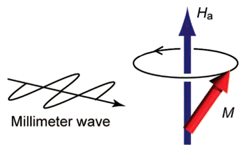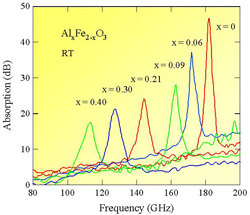Development of Electromagnetic Wave Absorber
for Sub-terahertz Region in ε-type AlxFe2-xO3
M. Nakajima, S. Ohkoshi, and T. Suemoto
Recently, we have been studying the development of the electromagnetic wave absorber for millimeter wave in sub-terahertz range. This range is very expected for next-generation wireless communication. The development of the electromagnetic absorber in higher frequency region is urgent theme needed for the next-generation wireless communication. In general, when an electromagnetic wave is irradiated to a ferromagnet, the resonance due to gyromagnetic effect is caused. This resonance is called a “natural resonance” (ferromagnetic resonance) (Fig. 1). The resonance frequency (fr) is proportional to a magnetocrystalline anisotropy field (Ha), which is expressed by fr = (ν / 2π) Ha, where ν is the gyromagnetic ratio. A magnetic material with a large coercive field (Hc) is expected to show a high-frequency resonance.

Fig.1. Schematic illustration of the natural resonance due to the gyromagnetic effect. Precession of magnetization (M) around an anisotropy field (Ha) causes electromagnetic wave absorption.

Fig. 2. The absorption spectra for ε-AlxFe2−xO3 from x = 0 to 0.40 measured by THz time domain spectroscopy.
The sample ε-Fe2O3 nanoparticles were prepared by an impregnation method based on mesoporous silica nanoparticles. The other samples for x = 0.06, 0.09, 0.21, 0.30, and 0.40 in ε-AlxFe2-xO3 were prepared by a combination method between the reverse-micelle and sol-gel techniques. The average particle sizes of the materials are between 25–50 nm. These nanomagnets have an extremely large Hc at 300 K of 10.2 kOe, 14.9 kOe, and 22.5 kOe for x = 0.4, 0.21, and 0, respectively. In addition, aluminum is the third most common atom, the production cost is very economical, which is very attractive for practical applications.
Terahertz (THz) time domain spectroscopy using THz pulses emitted by femtosecond laser pulse excitation is a powerful tool for investigating the millimeter wave and far-infrared region. The absorption measurement for ε-AlxFe2-xO3 was performed at room temperature using by THz domain spectroscopy. As a THz wave emitter and detector, a dipole-type and bow-tie type low-temperature-grown GaAs photoconductive antennas were used, respectively. The absorption spectra of the THz waves were calculated by the following equation: (Absorption) = −10 log|t(ω)|2 (dB) (t(ω); complex amplitude transmittance). An absorption of 20 dB indicates that 99 % of the introduced electromagnetic waves are absorbed, which is the target value for electromagnetic absorbers from an industrial point of view.
Figure 2 shows the absorption spectra. The frequencies of the absorption peaks for x= 0.40, 0.30, 0.21, 0.09, 0.06, and 0 were observed at 112, 125, 145,162, 172, and 182 GHz, respectively (Fig. 2). In the case of a ferromagnetic material with a uniaxial magnetic anisotropy, the direction of magnetization was restricted around the magnetic easy-axis. When an electromagnetic wave is irradiated to a ferromagnetic material, the magnetization precesses around the easy-axis and a natural resonance occurs. The fr value is proportional to the Ha. When the sample consists of randomly oriented magnetic particles, the Ha value is proportional to Hc. In fact, the fr value increased as the Hc value increases.
High-performance millimeter wave absorbers composed of a series of ε-AlxFe2-xO3 (0 ≤ x ≤ 0.40) nanomagnets were developed and investigated by the THz time domain spectroscopy. These magnetic materials exhibit natural resonances in the region of 112–182 GHz, which are the highest frequencies for magnetic materials. Such high natural resonance frequencies are achieved by the large magnetic anisotropies of this series.
References
- A. Namai, S. Sakurai, M. Nakajima, T. Suemoto, K. Matsumoto, M. Goto, S. Sasaki, and S. Ohkoshi, J. Am. Chem. Soc., 131, 1170-1173 (2009).
